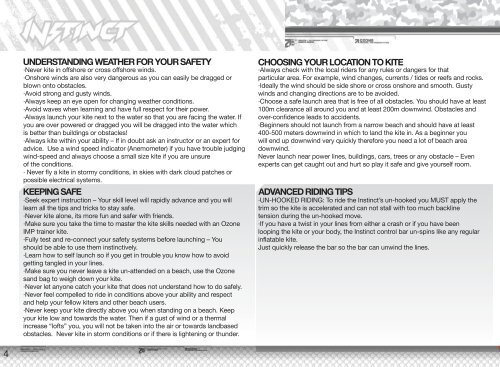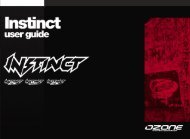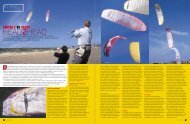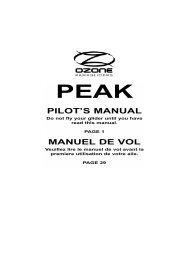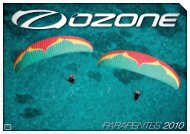Create successful ePaper yourself
Turn your PDF publications into a flip-book with our unique Google optimized e-Paper software.
4<br />
UNDERSTANDING WEATHER FOR YOUR SAFETY CHOOSING YOUR LOCATION TO KITE<br />
·Never kite in offshore or cross offshore winds.<br />
·Onshore winds are also very dangerous as you can easily be dragged or<br />
blown onto obstacles.<br />
·Avoid strong and gusty winds.<br />
·Always keep an eye open for changing weather conditions.<br />
·Avoid waves when learning and have full respect for their power.<br />
·Always launch your kite next to the water so that you are facing the water. If<br />
you are over powered or dragged you will be dragged into the water which<br />
is better than buildings or obstacles!<br />
·Always kite within your ability – If in doubt ask an instructor or an expert for<br />
advice. Use a wind speed indicator (Anemometer) if you have trouble judging<br />
wind-speed and always choose a small size kite if you are unsure<br />
of the conditions.<br />
· Never fly a kite in stormy conditions, in skies with dark cloud patches or<br />
possible electrical systems.<br />
KEEPING SAFE ADVANCED RIDING TIPS<br />
·Seek expert instruction – Your skill level will rapidly advance and you will<br />
learn all the tips and tricks to stay safe.<br />
·Never kite alone, its more fun and safer with friends.<br />
·Make sure you take the time to master the kite skills needed with an <strong>Ozone</strong><br />
IMP trainer kite.<br />
·Fully test and re-connect your safety systems before launching – You<br />
should be able to use them instinctively.<br />
·Learn how to self launch so if you get in trouble you know how to avoid<br />
getting tangled in your lines.<br />
·Make sure you never leave a kite un-attended on a beach, use the <strong>Ozone</strong><br />
sand bag to weigh down your kite.<br />
·Never let anyone catch your kite that does not understand how to do safely.<br />
·Never feel compelled to ride in conditions above your ability and respect<br />
and help your fellow kiters and other beach users.<br />
·Never keep your kite directly above you when standing on a beach. Keep<br />
your kite low and towards the water. Then if a gust of wind or a thermal<br />
increase “lofts” you, you will not be taken into the air or towards landbased<br />
obstacles. Never kite in storm conditions or if there is lightening or thunder.<br />
·Always check with the local riders for any rules or dangers for that<br />
particular area. For example, wind changes, currents / tides or reefs and rocks.<br />
·Ideally the wind should be side shore or cross onshore and smooth. Gusty<br />
winds and changing directions are to be avoided.<br />
·Choose a safe launch area that is free of all obstacles. You should have at least<br />
100m clearance all around you and at least 200m downwind. Obstacles and<br />
over-confidence leads to accidents.<br />
·Beginners should not launch from a narrow beach and should have at least<br />
400-500 meters downwind in which to land the kite in. As a beginner you<br />
will end up downwind very quickly therefore you need a lot of beach area<br />
downwind.<br />
Never launch near power lines, buildings, cars, trees or any obstacle – Even<br />
experts can get caught out and hurt so play it safe and give yourself room.<br />
·UN-HOOKED RIDING: To ride the Instinct’s un-hooked you MUST apply the<br />
trim so the kite is accelerated and can not stall with too much backline<br />
tension during the un-hooked move.<br />
·If you have a twist in your lines from either a crash or if you have been<br />
looping the kite or your body, the Instinct control bar un-spins like any regular<br />
inflatable kite.<br />
Just quickly release the bar so the bar can unwind the lines.


